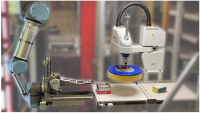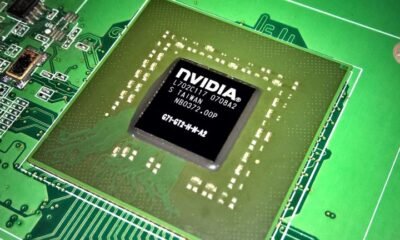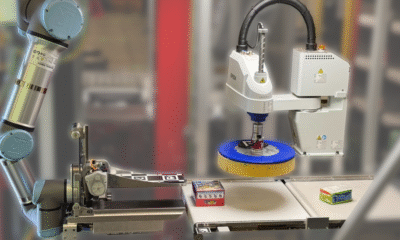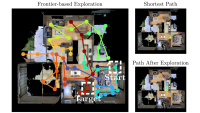Events & Conferences
Schooling robots to behave like fish
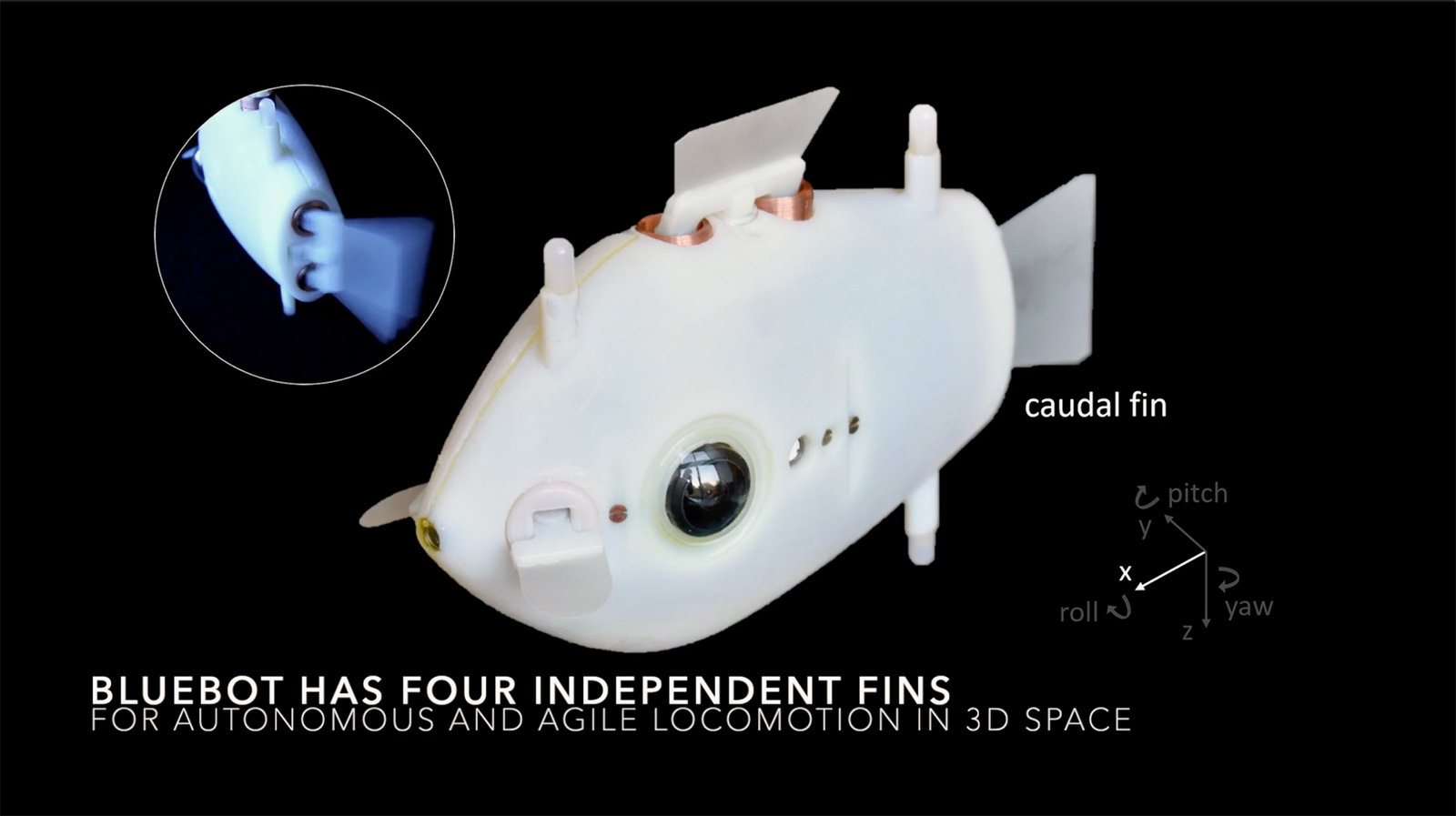
When Radhika Nagpal was starting graduate school in 1994, she and her future husband went snorkeling in the Caribbean. Nagpal, who grew up in a landlocked region of India, had never swum in the ocean before. It blew her away.
“The reef was super healthy and colorful, like being in a National Geographic television show,” she recalled. “As soon as I put my face in the water, this whole swarm of fish came towards me and then swerved to the right.”
Meet the Blueswarm
Blueswarm comprises seven identical miniature Bluebots that combine autonomous 3D multi-fin locomotion with 3D camera-based visual perception.
The fish fascinated her. As she watched, large schools of fish would suddenly stop or switch direction as if they were guided by a single mind. A series of questions occurred to her. How did they communicate with one another? What rules — think of them as algorithms — produced such complex group behaviors? What environmental prompts triggered their actions? And most importantly, what made collectives so much smarter and more successful than their individual members?
Since then, Nagpal, a professor of computer science at Harvard University’s Wyss Institute for Biologically Inspired Engineering and an Amazon Scholar, has gone on to build swarming robots. Swarm robotics involves scores of individual mobile robots that mimic the collective behavior demonstrated by animals, e.g. how flocks of birds or schools of fish move together to achieve some end. The robots act as if they, too, were guided by a single mind, or, more precisely, a single computer. Yet they are not.
Instead, they follow a relatively simple set of behavioral rules. Without any external orders or directions, Nagpal’s swarms organize themselves to carry out surprisingly complex tasks, like spontaneously synchronizing their behavior, creating patterns, and even building a tower.
More recently, her lab developed swimming robots that performed some of the same behaviors as a school of fish, such as aggregation, dispersion, and searching. All without a leader.
Nagpal’s work demonstrates both how far we have come in creating self-organizing robot swarms that can perform tasks — and how far we still must go to emulate the complex tapestries woven by nature. It is a gap that Nagpal hopes to close by uncovering the secrets of swarm intelligence to make swarm robots far more useful.
Amorphous computing
The Caribbean fish sparked Nagpal’s imagination because she was already interested in distributed computing, where multiple computers collaborate to solve problems or transfer information without any single computer running the show. At MIT, where she had begun her PhD program, she was drawn to an offshoot of the field called amorphous computing. It investigates how limited, unreliable individuals — from cells to ants to fish — organize themselves to perform often complex tasks consistently without any hierarchies.
Amorphous computing was “hardware agnostic.” This meant that it sought rules that guided this behavior in both living organisms and computer systems. It asked, for example, how identical cells in an embryo form all the organs of an animal, how ants find the most direct route to food, or how fish coordinate their movements. By studying nature, these computer scientists hoped to build computer networks that operated on the same principles.
I got excited about how nature makes these complicated, distributed, mobile networks. Those multi-robot systems became a new direction of my research
After completing her doctoral work on self-folding materials inspired by how cells form tissues, Nagpal began teaching at Harvard. While there, she was visited by her friend James McLurkin, a pioneer in swarm robotics at MIT and iRobot.
“James is the one that got me into robot swarms by introducing me to all the things that ant and termite colonies do,” Nagpal said. “I got excited about how nature makes these complicated, distributed, mobile networks. James was developing that used similar principles to move around and work together. Those multi-robot systems became a new direction of my research.”
She was particularly taken by Namibian termites, which build large-scale nest mounds with multiple chambers and complex ventilation systems, often as high as 8 feet tall.
“As far as we know, there isn’t a blueprint or an a priori distribution between who’s doing the building and who is not. We know the queen does not set the agenda,” she explained. “These colonies start with hundreds of termites and expand their structure as they grow.”
The question fascinated her. “I have no idea how that works,” she said. “I mean, how do you create systems that are so adaptive?”
Finding the rules
Researchers have spent decades answering that question. One way, they found, is to act locally. Take, for example, a flock of geese at a pond. If one or two birds on the outside of the flock see a predator, they grow agitated and fly off, alerting the next nearest birds. The message percolates through flock. Once a certain number of birds have “voted” to fly off, the rest follow without any hesitation. They are not following a leader, only reacting only to the birds next to them.
How dynamic circle formation works
The same type of local behaviors could be used to make driverless vehicles safer. An autonomous vehicle, Nagpal explains, does not have to reason about all the other cars on the road, only the ones around it. By focusing on nearby vehicles, these distributed systems use less processing power without losing the ability to react to changes very quickly.
Such systems are highly scalable. “Instead of having to reason about everybody, your car only has to reason about its five neighbors,” Nagpal said. “I can make the system very large, but each individual’s reasoning space remains constant. That’s a traditional notion of scalable —the amount of processing per vehicle stays constant, but we’re allowed to increase the size of the system.”
Another key to swarm behavior involves embodied intelligence, the idea that brains interact with the world through bodies that can see, hear, touch, smell, and taste. This is a type of intelligence, too, Nagpal argues.
It’s almost like each individual fish acts like a distributed sensor. Instead of me doing all the work, somebody on the left can say, ‘Hey, I saw something.’ When the group divides the labor so that some of us look out for predators while the rest of us eat, it costs less in terms of energy and resources.
“When you think of an ant, there is not a concentrated set of neurons there,” she said, referring to the ant’s 20-microgram brain. “Instead, there is a huge amount of awareness in the body itself. I may wonder how an ant solves a problem, but I have to realize that somehow having a physical body full of sensors makes that easier. We do not really understand how to think about that still.”
Local actions, scalable behavior, and embodied intelligence are among the factors that make swarms successful. In fact, researchers have shown that the larger a school of fish, the more successful it is at evading predators, finding food, and not getting lost.
“It’s almost like each individual fish acts like a distributed sensor,” Nagpal said. “Instead of me doing all the work, somebody on the left can say, ‘Hey, I saw something.’ When the group divides the labor so that some of us look out for predators while the rest of us eat, it costs less in terms of energy and resources than trying to eat and look out for predators all by yourself.
“What’s really interesting about large insect colonies and fish schools is that they do really complicated things in a decentralized way, whereas people have a tendency to build hierarchies as soon as we have to work together,” she continued. “There is a cost to that, and if we try to do that with that with robots, we replicate the whole management structure and cost of a hierarchy.”
So Nagpal set out to build robots swarms that worked without top-down organization.
Animal behavior
A typical process in Nagpal’s group starts by identifying an interesting natural behavior and trying to discover the rules that generate those actions. Sometimes, they are surprisingly simple.
Take, for example, some behaviors exhibited by Nagpal’s colony of 1,000 interactive robots, each the size of quarter and each communicating with its nearest neighbors wirelessly. The robots will self-assemble into a simple line with a repeating color pattern based on only two rules: a motion rule that allows them to move around any stationary robots, and a pattern rule that tells them to take on the color of their two nearest neighbors.
Other combinations of simple rules spontaneously synchronize the blinking of robot lights, guide migrations, and get the robots to form the letter “K.”
Most impressively, Nagpal and her lab used a behavior found in termites, called stigmergy, to prompt self-organized robot swarms to build a tower. Stigmergy involves leaving a mark on the environment that triggers a specific behavior by another member of the group.
Stigmergy plays a role in how termites build their huge nests. One termite may sense that a spot would make a good place to build, so it puts down its equivalent of a mud brick. When a second termite comes along, the brick triggers it to place its brick there. As the number of bricks increase, the trigger grows stronger and other termites begin building pillars nearby. When they grow high enough, something triggers the termites to begin connecting them with roofs.
“The building environment has become a physical memory of what should happen next,” Nagpal said.
Nagpal used that type of structural memory to prompt her robotic swarm to build a ziggurat tower. The instructions included a motion rule about how to move through the tower and a pattern rule about where to place the blocks. She then built some small, block-carrying robots that built a smaller but no less impressive structure.
Her lab developed a compiler that could generate algorithms that would enable the robots to build specific types of structures — perhaps towers with minarets — by interacting with stigmergic physical memories. One day, algorithm-driven robots could move sandbags to shore up a levee in a hurricane or buttress a collapsed building. They could even monitor coral reefs, underwater infrastructure, and pipelines — if they could swim.
Schooling robofish
From the start, Nagpal wanted to build her own school of robotic fish, but the hardware was simply too clunky to make them practical. That changed with the advent of smartphones, with their low-cost, low-power processors, sensors, and batteries.
In 2018, she got her chance when she received an Amazon Machine Learning Research Award. This allowed her to build Blueswarm, a group of robotic fish that performed tasks like those she observed in the Caribbean years ago.
Each Bluebot is just four inches long, but it packs a small Raspberry Pi computer, two fish-eye cameras, and three blue LED lights. It also has a tail (caudal) fin for thrust, a dorsal fin to move up or down, and side fins (pectoral fins) to turn, stop, or swim backward.
Bluebots do not use Wi-Fi, GPS, or external cameras to communicate their positions without error. Instead, she wants to explore what behaviors are possible relying only on cameras and local perception of one’s mates.
How multi-behavior search works
Researchers, she explained, find it difficult to rely only upon local perception. It has been difficult to tackle fundamental questions, like how does a robot visually detect other members of the swarm, how they parse information, and what happens when one member moves in front of another. Limiting Bluebot sensing to local perception forces Nagpal and her team to think more deeply about what robots really need to know about their neighbors, especially when data is limited and imprecise.
Bluebots can mimic several fish school behaviors by tracking LED lights on the neighboring fishbots around them. Using 3D cameras and simple algorithms, they estimate distance between lights on neighboring fish. (The closer they appear, the further the fish.)
Nagpal’s seven Bluebots form a circle (called milling) by turning right if there is a robot in front of them. If there is no robot, they turn left. After a few moments, the school will be swimming in a circle, a formation fish use to trap prey.
They can also search for a target flashing red light. First, the school disperses within the tank. When a Bluebot finds the red LED, it begins to flash its lights. This signals the nearest Bluebots to aggregate, followed by the rest. If a single robot had to conduct a similar search by itself, it would take significantly longer.
These behaviors are impressive for robots, but represent a small subset of fish school behaviors. They also take place in a static fish tank populated by only one school of robot fish. To go further, Nagpal wants to improve their sensors and perhaps use machine learning to discover new rules that could be combined to produce the aquatic equivalent of a tower.
In the end, though, Nagpal does not want to build a better fish. Instead, she wants to apply the lessons she has learned to real-world robots. She is doing just that during a sabbatical working at Amazon, which operates the largest fleet of robots — more than 200,000 units — in the world.
Practical uses
Nagpal had little previous experience working in industry, but she jumped at the chance to work with Amazon.
“There are few others with hundreds of robots moving around safely in a facility space,” she said. “And the opportunity to work on algorithms in a deployed system was very exciting.”
There are few others [like Amazon] with hundreds of robots moving around safely in a facility space. And the opportunity to work on algorithms in a deployed system was very exciting.
“The other factor is that Amazon’s robots do a mix of centralized and decentralized decision-making,” she continued. “The robots plan their own paths, but they also use the cloud to know more. That lets us ask: Is it better to know everything about all your neighbors all the time? Or is it better to only know about the neighbors that are closer to you?”
Her current focus is on sortation centers, where robots help route packages to shipping stations sorted by ZIP codes. Not surprisingly, robots setting out from multiple points to dozens of different locations require a degree of coordination. Amazon’s robots are already aware of other robots. If they see one, they will choose an alternate route. But what path should they take, Nagpal asks. She wants to make sure those robots are making the most effective possible choices.
Cities already manage this. They limit access to some roads, change speed limits, and add one-way streets. Computer networks do it as well, rerouting traffic when packet delivery slows down.
Some of those concepts, such as one-way travel lanes, also work in sortation centers. They could act as stigmergic signals to guide robot behavior. She also believes there might be a way to create simple swarm behaviors that enable robots to react to advanced data about incoming packages.
Once her sabbatical is over, Nagpal plans to return to the lab. She wants to keep working on her Bluebots, improving their vision, and turning them loose in environments that look more like the coral reef she went snorkeling in 25 years ago.
She is also dreaming of swarms of bigger robots for use in construction or trash collection.
“Maybe we could do what Amazon is doing, but do it outside,” she said. “We could have swarms of robots that actually do some sort of practical task. At Amazon, that task is delivery. But given Boston’s snowstorms, I think shoveling the sidewalks would be nice.”
Events & Conferences
A New Ranking Framework for Better Notification Quality on Instagram

- We’re sharing how Meta is applying machine learning (ML) and diversity algorithms to improve notification quality and user experience.
- We’ve introduced a diversity-aware notification ranking framework to reduce uniformity and deliver a more varied and engaging mix of notifications.
- This new framework reduces the volume of notifications and drives higher engagement rates through more diverse outreach.
Notifications are one of the most powerful tools for bringing people back to Instagram and enhancing engagement. Whether it’s a friend liking your photo, another close friend posting a story, or a suggestion for a reel you might enjoy, notifications help surface moments that matter in real time.
Instagram leverages machine learning (ML) models to decide who should get a notification, when to send it, and what content to include. These models are trained to optimize for user positive engagement such as click-through-rate (CTR) – the probability of a user clicking a notification – as well as other metrics like time spent.
However, while engagement-optimized models are effective at driving interactions, there’s a risk that they might overprioritize the product types and authors someone has previously engaged with. This can lead to overexposure to the same creators or the same product types while overlooking other valuable and diverse experiences.
This means people could miss out on content that would give them a more balanced, satisfying, and enriched experience. Over time, this can make notifications feel spammy and increase the likelihood that people will disable them altogether.
The real challenge lies in finding the right balance: How can we introduce meaningful diversity into the notification experience without sacrificing the personalization and relevance people on Instagram have come to expect?
To tackle this, we’ve introduced a diversity-aware notification ranking framework that helps deliver more diverse, better curated, and less repetitive notifications. This framework has significantly reduced daily notification volume while improving CTR. It also introduces several benefits:
- The extensibility of incorporating customized soft penalty (demotion) logic for each dimension, enabling more adaptive and sophisticated diversity strategies.
- The flexibility of tuning demotion strength across dimensions like content, author, and product type via adjustable weights.
- The integration of balancing personalization and diversity, ensuring notifications remain both relevant and varied.
The Risks of Notifications without Diversity
The issue of overexposure in notifications often shows up in two major ways:
Overexposure to the same author: People might receive notifications that are mostly about the same friend. For example, if someone often interacts with content from a particular friend, the system may continue surfacing notifications from that person alone – ignoring other friends they also engage with. This can feel repetitive and one-dimensional, reducing the overall value of notifications.
Overexposure to the same product surface: People might mostly receive notifications from the same product surface such as Stories, even when Feed or Reels could provide value. For example, someone may be interested in both reel and story notifications but has recently interacted more often with stories. Because the system heavily prioritizes past engagement, it sends only story notifications, overlooking the person’s broader interests.
Introducing Instagram’s Diversity-Aware Notification Ranking Framework
Instagram’s diversity-aware notification ranking framework is designed to enhance the notification experience by balancing the predicted potential for user engagement with the need for content diversity. This framework introduces a diversity layer on top of the existing engagement ML models, applying multiplicative penalties to the candidate scores generated by these models, as figure1, below, shows.
The diversity layer evaluates each notification candidate’s similarity to recently sent notifications across multiple dimensions such as content, author, notification type, and product surface. It then applies carefully calibrated penalties—expressed as multiplicative demotion factors—to downrank candidates that are too similar or repetitive. The adjusted scores are used to re-rank the candidates, enabling the system to select notifications that maintain high engagement potential while introducing meaningful diversity. In the end, the quality bar selects the top-ranked candidate that passes both the ranking and diversity criteria.
Mathematical Formulation
Within the diversity layer, we apply a multiplicative demotion factor to the base relevance score of each candidate. Given a notification candidate 𝑐, we compute its final score as the product of its base ranking score and a diversity demotion multiplier:
where R(c) represents the candidate’s base relevance score, and D(c) ∈ [0,1] is a penalty factor that reduces the score based on similarity to recently sent notifications. We define a set of semantic dimensions (e.g., author, product type) along which we want to promote diversity. For each dimension i, we compute a similarity signal pi(c) between candidate c and the set of historical notifications H, using a maximal marginal relevance (MMR) approach:
where simi(·,·) is a predefined similarity function for dimension i. In our baseline implementation, pi(c) is binary: it equals 1 if the similarity exceeds a threshold 𝜏i and 0 otherwise.
The final demotion multiplier is defined as:
where each wi ∈ [0,1] controls the strength of demotion for its respective dimension. This formulation ensures that candidates similar to previously delivered notifications along one or more dimensions are proportionally down-weighted, reducing redundancy and promoting content variation. The use of a multiplicative penalty allows for flexible control across multiple dimensions, while still preserving high-relevance candidates.
The Future of Diversity-Aware Ranking
As we continue evolving our notification diversity-aware ranking system, a next step is to introduce more adaptive, dynamic demotion strategies. Instead of relying on static rules, we plan to make demotion strength responsive to notification volume and delivery timing. For example, as a user receives more notifications—especially of similar type or in rapid succession—the system progressively applies stronger penalties to new notification candidates, effectively mitigating overwhelming experiences caused by high notification volume or tightly spaced deliveries.
Longer term, we see an opportunity to bring large language models (LLMs) into the diversity pipeline. LLMs can help us go beyond surface-level rules by understanding semantic similarity between messages and rephrasing content in more varied, user-friendly ways. This would allow us to personalize notification experiences with richer language and improved relevance while maintaining diversity across topics, tone, and timing.
Events & Conferences
Simplifying book discovery with ML-powered visual autocomplete suggestions

Every day, millions of customers search for books in various formats (audiobooks, e-books, and physical books) across Amazon and Audible. Traditional keyword autocomplete suggestions, while helpful, usually require several steps before customers find their desired content. Audible took on the challenge of making book discovery more intuitive and personalized while reducing the number of steps to purchase.
We developed an instant visual autocomplete system that enhances the search experience across Amazon and Audible. As the user begins typing a query, our solution provides visual previews with book covers, enabling direct navigation to relevant landing pages instead of the search result page. It also delivers real-time personalized format recommendations and incorporates multiple searchable entities, such as book pages, author pages, and series pages.
Our system needed to understand user intent from just a few keystrokes and determine the most relevant books to display, all while maintaining low latency for millions of queries. Using historical search data, we match keystrokes to products, transforming partial inputs into meaningful search suggestions. To ensure quality, we implemented confidence-based filtering mechanisms, which are particularly important for distinguishing between general queries like “mystery” and specific title searches. To reflect customers’ most recent interests, the system applies time-decay functions to long historical user interaction data.
To meet the unique requirements of each use case, we developed two distinct technical approaches. On Audible, we deployed a deep pairwise-learning-to-rank (DeepPLTR) model. The DeepPLTR model considers pairs of books and learns to assign a higher score to the one that better matches the customer query.
The DeepPLTR model’s architecture consists of three specialized towers. The left tower factors in contextual features and recent search patterns using a long-short-term-memory model, which processes data sequentially and considers its prior decisions when issuing a new term in the sequence. The middle tower handles keyword and item engagement history. The right tower factors in customer taste preferences and product descriptions to enable personalization. The model learns from paired examples, but at runtime, it relies on books’ absolute scores to assemble a ranked list.
For Amazon, we implemented a two-stage modeling approach involving a probabilistic information-retrieval model to determine the book title that best matches each keyword and a second model that personalizes the book format (audiobooks, e-books, and physical books). This dual-strategy approach maintains low latency while still enabling personalization.
In practice, a customer who types “dungeon craw” in the search bar now sees a visual recommendation for the book Dungeon Crawler Carl, complete with book cover, reducing friction by bypassing a search results page and sending the customer directly to the product detail page. On Audible, the system also personalizes autocomplete results and enriches the discovery experience with relevant connections. These include links to the author’s complete works (Matt Dinniman’s author page) and, for titles that belong to a series, links to the full collection (such as the Dungeon Crawler Carl series).
On Amazon, when the customer clicks on the title, the model personalizes the right book-format (audiobooks, e-books, physical books) recommendation and directs the customer to the right product detail page.
In both cases, after the customer has entered a certain number of keystrokes, the system employs a model to detect customer intent (e.g., book title intent for Amazon or author intent for Audible) and determine which visual widget should be displayed.
Audible and Amazon books’ visual autocomplete provides customers with more relevant content more rapidly than traditional autocomplete, and its direct navigation reduces the number of steps to find and access desired books — all while handling millions of queries at low latency.
This technology is not just about making book discovery easier; it is laying the foundation for future improvements in search personalization and visual discovery across Amazon’s ecosystem.
Acknowledgements: Jiun Kim, Sumit Khetan, Armen Stepanyan, Jack Xuan, Nathan Brothers, Eddie Chen, Vincent Lee, Soumy Ladha, Justine Luo, Yuchen Zeng, David Torres, Gali Deutsch, Chaitra Ramdas, Christopher Gomez, Sharmila Tamby, Melissa Ma, Cheng Luo, Jeffrey Jiang, Pavel Fedorov, Ronald Denaux, Aishwarya Vasanth, Azad Bajaj, Mary Heer, Adam Lowe, Jenny Wang, Cameron Cramer, Emmanuel Ankrah, Lydia Diaz, Suzette Islam, Fei Gu, Phil Weaver, Huan Xue, Kimmy Dai, Evangeline Yang, Chao Zhu, Anvy Tran, Jessica Wu, Xiaoxiong Huang, Jiushan Yang
Events & Conferences
Revolutionizing warehouse automation with scientific simulation

Modern warehouses rely on complex networks of sensors to enable safe and efficient operations. These sensors must detect everything from packages and containers to robots and vehicles, often in changing environments with varying lighting conditions. More important for Amazon, we need to be able to detect barcodes in an efficient way.
The Amazon Robotics ID (ARID) team focuses on solving this problem. When we first started working on it, we faced a significant bottleneck: optimizing sensor placement required weeks or months of physical prototyping and real-world testing, severely limiting our ability to explore innovative solutions.
To transform this process, we developed Sensor Workbench (SWB), a sensor simulation platform built on NVIDIA’s Isaac Sim that combines parallel processing, physics-based sensor modeling, and high-fidelity 3-D environments. By providing virtual testing environments that mirror real-world conditions with unprecedented accuracy, SWB allows our teams to explore hundreds of configurations in the same amount of time it previously took to test just a few physical setups.
Camera and target selection/positioning
Sensor Workbench users can select different cameras and targets and position them in 3-D space to receive real-time feedback on barcode decodability.
Three key innovations enabled SWB: a specialized parallel-computing architecture that performs simulation tasks across the GPU; a custom CAD-to-OpenUSD (Universal Scene Description) pipeline; and the use of OpenUSD as the ground truth throughout the simulation process.
Parallel-computing architecture
Our parallel-processing pipeline leverages NVIDIA’s Warp library with custom computation kernels to maximize GPU utilization. By maintaining 3-D objects persistently in GPU memory and updating transforms only when objects move, we eliminate redundant data transfers. We also perform computations only when needed — when, for instance, a sensor parameter changes, or something moves. By these means, we achieve real-time performance.
Visualization methods
Sensor Workbench users can pick sphere- or plane-based visualizations, to see how the positions and rotations of individual barcodes affect performance.
This architecture allows us to perform complex calculations for multiple sensors simultaneously, enabling instant feedback in the form of immersive 3-D visuals. Those visuals represent metrics that barcode-detection machine-learning models need to work, as teams adjust sensor positions and parameters in the environment.
CAD to USD
Our second innovation involved developing a custom CAD-to-OpenUSD pipeline that automatically converts detailed warehouse models into optimized 3-D assets. Our CAD-to-USD conversion pipeline replicates the structure and content of models created in the modeling program SolidWorks with a 1:1 mapping. We start by extracting essential data — including world transforms, mesh geometry, material properties, and joint information — from the CAD file. The full assembly-and-part hierarchy is preserved so that the resulting USD stage mirrors the CAD tree structure exactly.
To ensure modularity and maintainability, we organize the data into separate USD layers covering mesh, materials, joints, and transforms. This layered approach ensures that the converted USD file faithfully retains the asset structure, geometry, and visual fidelity of the original CAD model, enabling accurate and scalable integration for real-time visualization, simulation, and collaboration.
OpenUSD as ground truth
The third important factor was our novel approach to using OpenUSD as the ground truth throughout the entire simulation process. We developed custom schemas that extend beyond basic 3-D-asset information to include enriched environment descriptions and simulation parameters. Our system continuously records all scene activities — from sensor positions and orientations to object movements and parameter changes — directly into the USD stage in real time. We even maintain user interface elements and their states within USD, enabling us to restore not just the simulation configuration but the complete user interface state as well.
This architecture ensures that when USD initial configurations change, the simulation automatically adapts without requiring modifications to the core software. By maintaining this live synchronization between the simulation state and the USD representation, we create a reliable source of truth that captures the complete state of the simulation environment, allowing users to save and re-create simulation configurations exactly as needed. The interfaces simply reflect the state of the world, creating a flexible and maintainable system that can evolve with our needs.
Application
With SWB, our teams can now rapidly evaluate sensor mounting positions and verify overall concepts in a fraction of the time previously required. More importantly, SWB has become a powerful platform for cross-functional collaboration, allowing engineers, scientists, and operational teams to work together in real time, visualizing and adjusting sensor configurations while immediately seeing the impact of their changes and sharing their results with each other.
New perspectives
In projection mode, an explicit target is not needed. Instead, Sensor Workbench uses the whole environment as a target, projecting rays from the camera to identify locations for barcode placement. Users can also switch between a comprehensive three-quarters view and the perspectives of individual cameras.
Due to the initial success in simulating barcode-reading scenarios, we have expanded SWB’s capabilities to incorporate high-fidelity lighting simulations. This allows teams to iterate on new baffle and light designs, further optimizing the conditions for reliable barcode detection, while ensuring that lighting conditions are safe for human eyes, too. Teams can now explore various lighting conditions, target positions, and sensor configurations simultaneously, gleaning insights that would take months to accumulate through traditional testing methods.
Looking ahead, we are working on several exciting enhancements to the system. Our current focus is on integrating more-advanced sensor simulations that combine analytical models with real-world measurement feedback from the ARID team, further increasing the system’s accuracy and practical utility. We are also exploring the use of AI to suggest optimal sensor placements for new station designs, which could potentially identify novel configurations that users of the tool might not consider.
Additionally, we are looking to expand the system to serve as a comprehensive synthetic-data generation platform. This will go beyond just simulating barcode-detection scenarios, providing a full digital environment for testing sensors and algorithms. This capability will let teams validate and train their systems using diverse, automatically generated datasets that capture the full range of conditions they might encounter in real-world operations.
By combining advanced scientific computing with practical industrial applications, SWB represents a significant step forward in warehouse automation development. The platform demonstrates how sophisticated simulation tools can dramatically accelerate innovation in complex industrial systems. As we continue to enhance the system with new capabilities, we are excited about its potential to further transform and set new standards for warehouse automation.
-

 Business5 days ago
Business5 days agoThe Guardian view on Trump and the Fed: independence is no substitute for accountability | Editorial
-
Tools & Platforms3 weeks ago
Building Trust in Military AI Starts with Opening the Black Box – War on the Rocks
-

 Ethics & Policy1 month ago
Ethics & Policy1 month agoSDAIA Supports Saudi Arabia’s Leadership in Shaping Global AI Ethics, Policy, and Research – وكالة الأنباء السعودية
-

 Events & Conferences4 months ago
Events & Conferences4 months agoJourney to 1000 models: Scaling Instagram’s recommendation system
-

 Jobs & Careers2 months ago
Jobs & Careers2 months agoMumbai-based Perplexity Alternative Has 60k+ Users Without Funding
-

 Education2 months ago
Education2 months agoVEX Robotics launches AI-powered classroom robotics system
-

 Funding & Business2 months ago
Funding & Business2 months agoKayak and Expedia race to build AI travel agents that turn social posts into itineraries
-

 Podcasts & Talks2 months ago
Podcasts & Talks2 months agoHappy 4th of July! 🎆 Made with Veo 3 in Gemini
-

 Podcasts & Talks2 months ago
Podcasts & Talks2 months agoOpenAI 🤝 @teamganassi
-

 Education2 months ago
Education2 months agoAERDF highlights the latest PreK-12 discoveries and inventions


